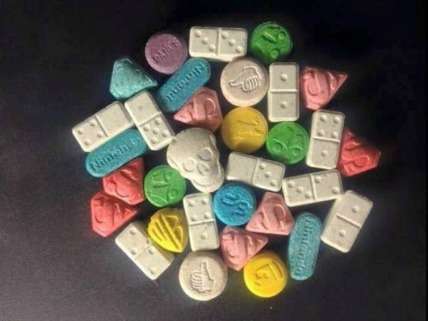New Study Confirms That Molly Users Don't Know What They're Taking
Surveys combined with hair tests indicate that MDMA adulteration is common.

A new study provides additional evidence that pills or powders sold as MDMA—even ostensibly pure "molly"—frequently contain synthetic cathinones (a.k.a. "bath salts") or other substitutes. Beginning with a sample of "679 nightclub and festival attendees in New York City," the researchers focused on 48 subjects who reported MDMA use in an electronic survey and provided adequate hair samples for drug testing. Of the 34 who reported no use of "bath salts," other recently popularized stimulants, or "unknown pills or powders," two-fifths nevertheless tested positive for a "novel psychoactive substance" (NPS), most commonly butylone. Reporting their findings in the journal Drug and Alcohol Dependence, NYU public health researcher Joseph Palamar and his co-authors say "our results suggest that many ecstasy users are unintentionally or unknowingly using synthetic cathinones and/or other NPS."
This sort of adulteration, a familiar side effect of prohibition, is worrisome not just because consumers are getting ripped off but because MDMA substitutes may be more dangerous than the real thing. While poisoning reports involving "bath salts" fell by 92 percent between 2011 and 2015, Palamar et al. note, "rates of poisonings related to [MDMA] use have increased in the US, and this may be due, in part, to users unknowingly using NPS such as synthetic cathinones in their ecstasy." To help address this problem, the authors suggest "prevention and harm reduction education," pill testing "for those rejecting abstinence," and more systematic analysis of purported MDMA seized by law enforcement agencies.
"Ecstasy wasn't always such a dangerous drug, but it is becoming increasingly risky because it has become so adulterated with new drugs that users and the scientific community alike know very little about," Palamar says in an NYU press release. "Users need to be aware that what they are taking may not be MDMA."
Apparently none of that was sexy enough for Ars Technica, whose story about this study was headlined "Violence-Inducing Bath Salts May Be Common Hidden Ingredient in Party Drug." In their report, Palamar and his colleagues do not mention violence at all, let alone an increase among MDMA-popping electronic music fans. Nor does Ars Technica reporter Beth Mole cite any evidence that synthetic cathinones induce violence. The one incident she mentions—"a 2012 case in which a Miami man ate a homeless man's face"—involved an attacker who tested negative for synthetic cathinones, as she herself acknowledges.
"A lot of people laughed when they gave us their hair," says Palamar, recalling comments such as, "I don't use bath salts; I'm not a zombie who eats people's faces." He adds that "our findings suggest many of these people have been using 'bath salts' without realizing it." In other words, the vicious attacker who supposedly was high on "bath salts" had not actually taken them, while people who take them but think they are taking Molly behave about as violently as the average MDMA user. But one thing we know for sure: Bath salts make people violent.
[Thanks to Ron Steiner for the Ars Technica link.]



Show Comments (29)